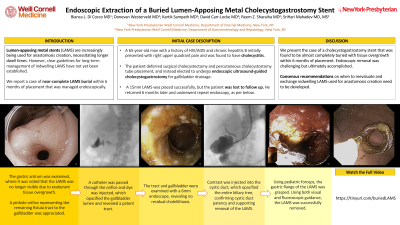Monday Poster Session
Category: Endoscopy Video Forum
P1797 - Endoscopic Extraction of a Buried Lumen-Apposing Metal Cholecystogastrostomy Stent


Bianca Di Cocco, MD
New York-Presbyterian/Weill Cornell Medical Center
New York, NY
Presenting Author(s)
1New York-Presbyterian/Weill Cornell Medical Center, New York, NY; 2New York-Presbyterian Hospital/Weill Cornell Medical Center, New York, NY
Introduction:
Lumen-apposing metal stents (LAMS) are increasingly being used for anastomosis creation, necessitating longer dwell times. However, clear guidelines for long-term management of indwelling LAMS have not been established. We report a case of near-complete LAMS burial within 6 months of placement that was managed endoscopically.
Case Description/Methods:
A 65-year-old man with a history of HIV/AIDS and chronic hepatitis B initially presented with right upper quadrant pain and was found to have cholecystitis. The patient deferred surgical cholecystectomy and percutaneous cholecystostomy tube placement, and instead elected to undergo endoscopic ultrasound-guided cholecystogastrostomy for gallbladder drainage. A 15mm LAMS was placed successfully, but the patient was lost to follow up. He returned 6 months later and underwent repeat endoscopy for cholecystoscopy, stone extraction, and possible LAMS removal.
The gastric antrum was examined, where it was noted that the LAMS was no longer visible due to exuberant tissue overgrowth. A pinhole orifice representing the remaining fistula tract to the gallbladder was appreciated. A catheter was passed through the orifice and dye was injected, which opacified the gallbladder lumen and revealed a patent tract. The tract and gallbladder were examined with a 6mm endoscope, revealing no residual cholelithiasis, and contrast was injected into the cystic duct, which opacified the entire biliary tree. Using pediatric forceps, the gastric flange of the LAMS was then grasped, and using both visual and fluoroscopic guidance, the LAMS was successfully removed.
Discussion:
We present the case of a cholecystogastrostomy stent that was found to be almost completely buried with tissue overgrowth within 6 months of placement. Endoscopic removal was challenging but ultimately accomplished. Consensus recommendations on when to reevaluate and exchange indwelling LAMS used for anastomosis creation need to be developed.
Disclosures:
Bianca Di Cocco, MD1, Donevan Westerveld, MD1, Kartik Sampath, MD2, David Carr-Locke, MD1, Reem Sharaiha, MD2, SriHari Mahadev, MD, MS1. P1797 - Endoscopic Extraction of a Buried Lumen-Apposing Metal Cholecystogastrostomy Stent, ACG 2023 Annual Scientific Meeting Abstracts. Vancouver, BC, Canada: American College of Gastroenterology.
